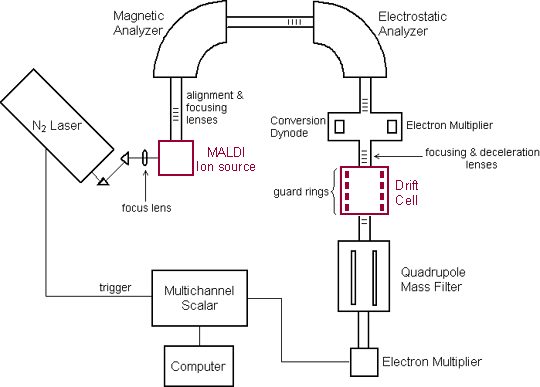|
This
instrument has been taken out of service
Overall
Design
The
first ion mobility instrument used in our lab was built in ~1989. The
overall schematic of the instrument is shown below and essentially consists
of a reverse-geometry mass spectrometer coupled to a high-pressure, temperature
variable drift cell.
The mass spectrometer is similar to a V.G. (now
Waters/Micromass) ZAB-2F instrument with a magnetic and electric sector. A variety
of ion sources can be used with this instrument including EI/CI, laser
vaporization, and more recently matrix-assisted
laser desorption/ionization (MALDI). Ions exiting the source are accelerated
to 5 kV and mass analyzed with the sector mass spectrometer. Mass spectra
can be obtained at an off-axis detector just before the drift cell by
scanning the magnet. The magnet has an upper mass range of ~m/z 1400.
For the ion mobility experiments, the magnet is
tuned for the ion of interest and the conversion dynode is turned off.
The mass-selected ions are then decelerated to 5-15 eV and focused onto
the entrance of the drift cell. The cell is filled
with ~3 Torr of He and the ions travel through it under the influence
of a weak, uniform electric field. After exiting the cell, the ions pass
through a quadrupole mass filter and are detected with an electron multiplier
operated in pulse counting mode.
In the MALDI experiments, the laser pulse triggers
a timer so that the ions hitting the detector are collected as a function
of time using simple pulse counting techniques. For the continuous ion
sources such as EI/CI, a gate just before the drift cell is turned on
to pulse the ions into the cell. The arrival time data is collected on
a multichannel scalar with a 2 microsecond bin width.
|
|



